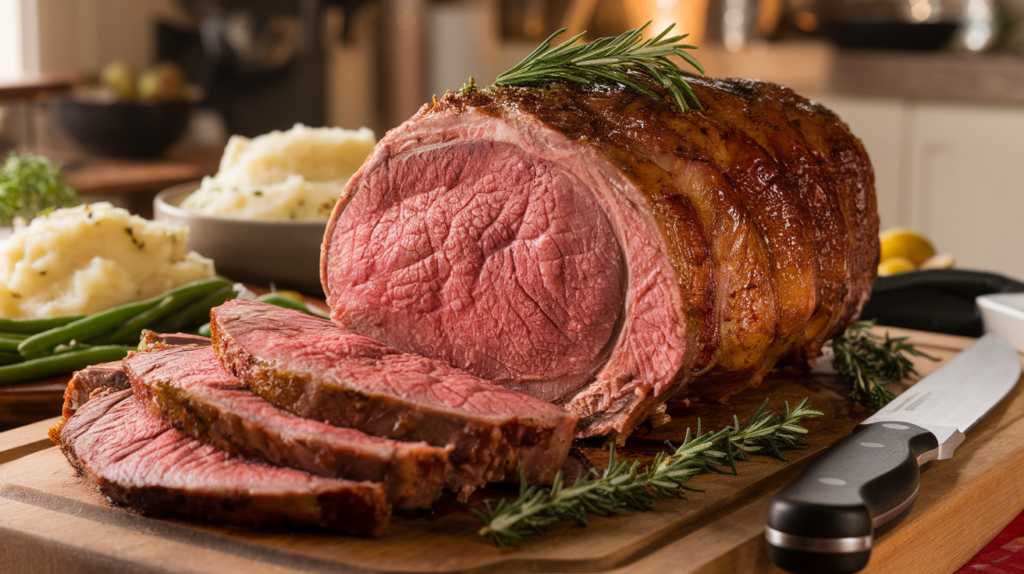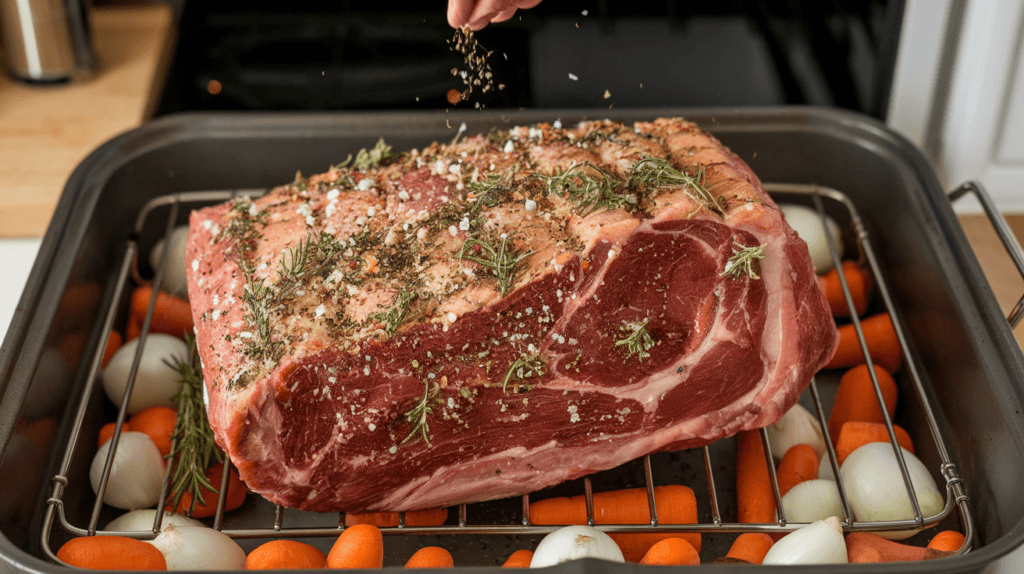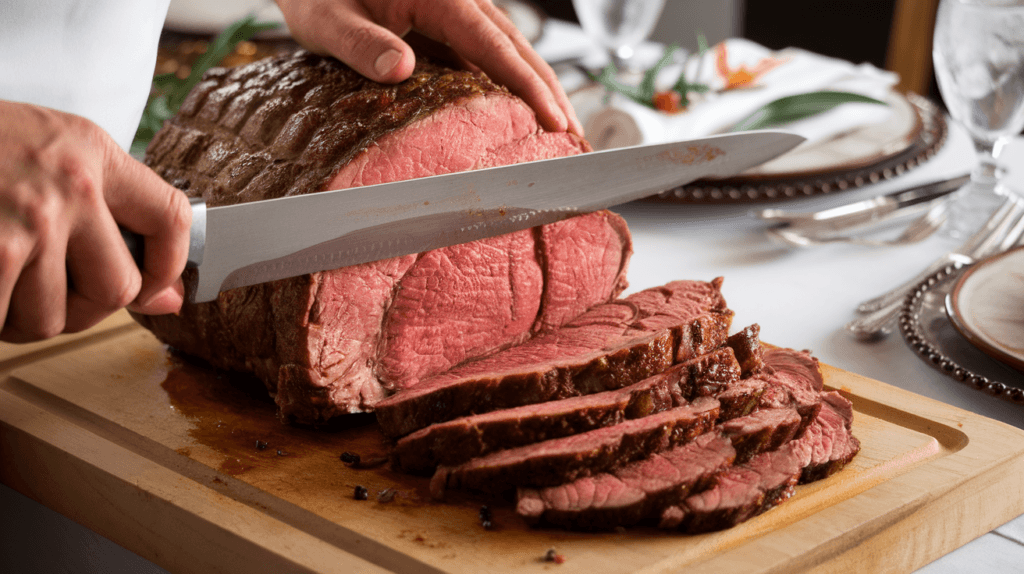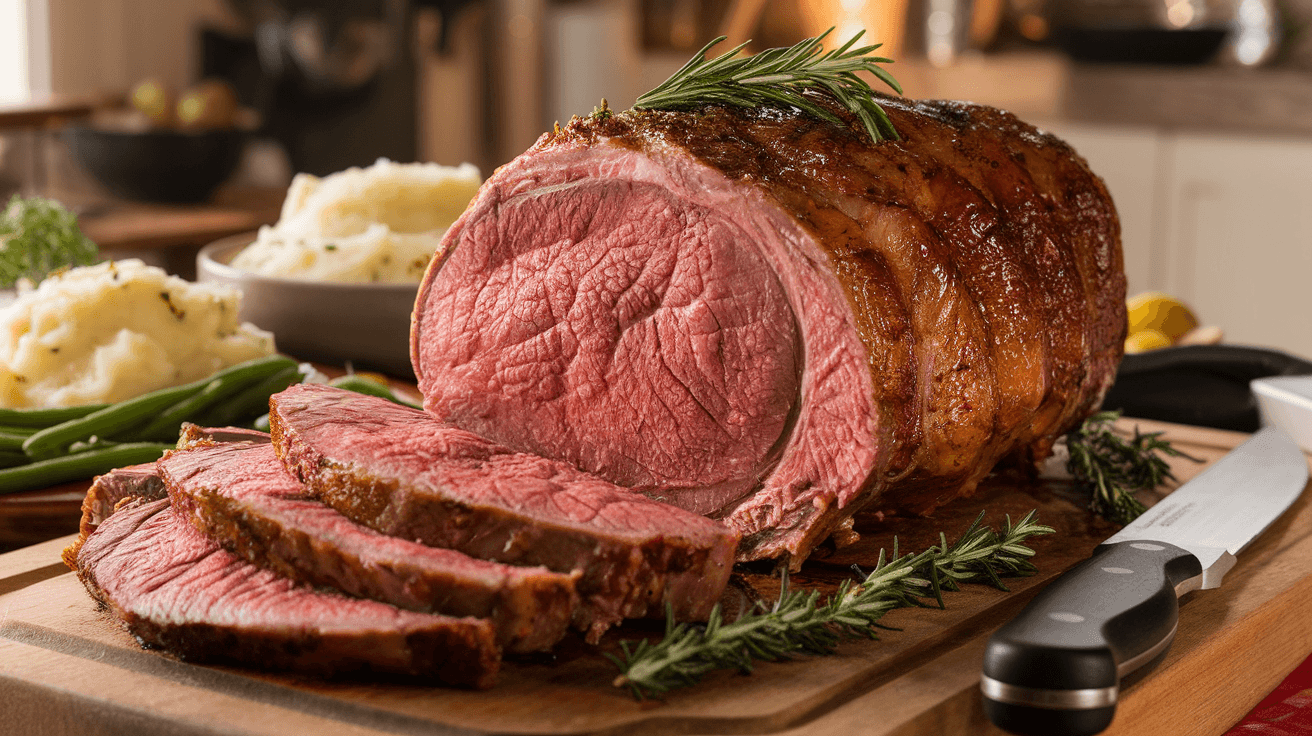Introduction

Cooking a 5 lb prime rib is a culinary task that many home chefs find both exciting and intimidating. Whether you’re preparing a holiday feast or a special dinner, understanding the cooking time and process is key to achieving a juicy and flavorful roast. But how long does it actually take to cook a 5 lb prime rib? The answer depends on several factors, including the desired doneness, oven temperature, and preparation techniques.
This article answers the question, “How long does it take to cook a 5 lb prime rib?“, offering a detailed guide to cooking it to perfection. We’ll explore the factors influencing cooking time, tips for achieving the best results, and common mistakes to avoid. By the end, you’ll know exactly how to confidently prepare this show-stopping dish.
Let’s dive into the specifics of cooking a prime rib, starting with understanding what makes this cut of meat so special.
What is Prime Rib?
Understanding the Cut
Prime rib, also known as a standing rib roast, is a classic cut of beef taken from the primal rib section. This luxurious roast is celebrated for its marbling, tenderness, and rich flavor, making it a centerpiece for special occasions and holiday dinners. It typically includes a section of the rib bones, which can enhance the flavor and help with even cooking.
The term “prime rib” often leads people to ask, “How long does it take to cook a 5 lb prime rib?” It is commonly associated with high-quality meat, but not all prime ribs are labeled as “prime grade” by the USDA. The grade refers to the level of marbling and overall quality, with “prime” being the highest grade, followed by “choice” and “select.” Knowing the grade can help determine the best cooking techniques and timing.
Why Size Matters in Cooking
Cooking times for a prime rib vary significantly based on the size and weight of the roast. A 5 lb prime rib is considered medium-sized and is perfect for serving 4 to 6 people. Larger roasts require longer cooking times, while smaller ones cook more quickly. The size also affects the meat’s ability to retain heat, making precise temperature control essential for consistent results.
Understanding your specific cut and size will help you adjust your cooking techniques to achieve the perfect balance of tenderness and doneness.
What is Prime Rib?
Understanding the Cut
Prime rib, also known as a standing rib roast, is a premium cut of beef taken from the rib section of the cow. This cut is prized for its tenderness, rich marbling, and deep flavor. Unlike other cuts, prime rib includes a portion of the rib bone, which enhances its presentation and contributes to its robust taste when cooked.
One of the reasons prime rib is so popular is its versatility in preparation. Whether you prefer it rare, medium-rare, or well-done, the cut’s high fat content ensures it remains juicy and flavorful, provided it’s cooked correctly.
Why Size Matters in Cooking
The size of the prime rib significantly affects the cooking time. A 5 lb prime rib is ideal for smaller gatherings, typically serving 6–8 people, depending on portion sizes. The weight determines how long it takes for the heat to penetrate to the center of the roast. Additionally, the size impacts other factors, such as resting time and the consistency of the doneness throughout the roast.
Understanding the specifics of the cut ensures you can prepare it with confidence and precision. Next, let’s look at the key factors that influence cooking time.
Key Factors Affecting Cooking Time
Meat Temperature Before Cooking
One of the most important factors that determine cooking time is the temperature of the meat before it goes into the oven. Bringing the 5 lb prime rib to room temperature ensures even cooking. If the meat is cold from the refrigerator, it will take longer for the heat to reach the center, potentially leading to uneven doneness.
To prepare the meat, remove it from the refrigerator at least 1–2 hours before cooking. This step is essential when considering how long it takes to cook a 5 lb prime rib, as it allows the roast to warm up slightly. Doing so reduces cooking time and ensures it cooks evenly throughout.
Oven Settings and Precision
The oven temperature you choose has a direct impact on cooking time. Common temperatures for roasting prime rib range from 225°F (low and slow) to 450°F (for a high-heat sear). Each approach has its benefits:
- Low and Slow (225°F–250°F): This method ensures even cooking and maximum tenderness. It’s ideal for achieving consistent doneness throughout the roast.
- High Heat (450°F–500°F): Starting with high heat creates a flavorful crust, but it requires careful monitoring to avoid overcooking the interior.
Using a reliable oven thermometer is essential to ensure accuracy, as oven temperature variations can affect cooking time and final results.
Desired Doneness
Your preferred level of doneness—rare, medium-rare, medium, or well-done—also affects the cooking time. For a 5 lb prime rib:
- Rare: 120°F–125°F internal temperature
- Medium-Rare: 130°F–135°F internal temperature
- Medium: 140°F–145°F internal temperature
- Well-Done: 150°F–160°F internal temperature
Each level of doneness requires a different cooking time. Using a meat thermometer to monitor the internal temperature is the most accurate way to achieve your desired doneness.
With these factors in mind, you’re ready to start preparing your roast. In the next section, we’ll provide a step-by-step guide to cooking a 5 lb prime rib.
Step-by-Step Guide to Cooking a 5 lb Prime Rib

Preparing the Meat
Preparation is key to ensuring your 5 lb prime rib cooks evenly and develops rich flavors. Follow these steps to get started:
- Bring to Room Temperature: Remove the roast from the refrigerator 1–2 hours before cooking. This ensures even cooking throughout the meat.
- Season Generously: Create a seasoning rub using kosher salt, freshly ground black pepper, garlic powder, and herbs such as rosemary or thyme. Rub this mixture all over the roast, including the sides and edges.
- Optional Searing: For a flavorful crust, you can sear the roast in a hot skillet with a small amount of oil before placing it in the oven. This step is optional and depends on your preferred cooking method.
Setting the Oven Temperature
Choosing the right oven temperature is critical for cooking a prime rib. Here’s a common two-step method:
- Initial High Heat: Preheat your oven to 450°F and cook the roast for the first 15–20 minutes. This creates a seared crust.
- Lower the Heat: Reduce the oven temperature to 325°F and continue roasting until the desired internal temperature is reached.
Using this method helps achieve a perfect balance of a flavorful exterior and tender interior.
Monitoring Cooking Progress
Invest in a quality meat thermometer to monitor the internal temperature of your roast. Insert the thermometer into the thickest part of the meat, avoiding the bone if your cut includes one. Check the temperature periodically to avoid overcooking.
For a 5 lb prime rib, the approximate cooking times are as follows:
- Rare (120°F–125°F): 1 hour 45 minutes to 2 hours
- Medium-Rare (130°F–135°F): 2 hours to 2 hours 15 minutes
- Medium (140°F–145°F): 2 hours 15 minutes to 2 hours 30 minutes
Always remove the roast from the oven when it’s about 5°F below your target temperature, as it will continue to cook during resting.
Next, let’s look at a detailed cooking time chart to help you plan more precisely.
Cooking Time Chart for Prime Rib
Rare, Medium Rare, and Well Done Options
To achieve the perfect prime rib, it’s crucial to know the recommended cooking times for your desired level of doneness. Below is a helpful cooking time chart for a 5 lb prime rib:
| Doneness | Internal Temperature | Approximate Cooking Time |
|---|---|---|
| Rare | 120°F–125°F | 1 hour 45 minutes – 2 hours |
| Medium Rare | 130°F–135°F | 2 hours – 2 hours 15 minutes |
| Medium | 140°F–145°F | 2 hours 15 minutes – 2 hours 30 minutes |
| Well Done | 150°F–160°F | 2 hours 45 minutes – 3 hours |
These times are based on roasting at 325°F after an initial sear at 450°F. Use a meat thermometer to ensure precision, as oven performance can vary.
Adjustments for Bone-In vs. Boneless Prime Rib
If your 5 lb prime rib includes the bone, the cooking time may increase slightly. The bone acts as an insulator, slowing the cooking process. Generally, you can add 10–15 minutes to the total cooking time for bone-in cuts compared to boneless ones.
It’s also worth noting that bone-in prime rib tends to retain more flavor due to the marrow’s contribution to the cooking process. For both options, always rely on a meat thermometer to determine when the roast is done.
Next, we’ll explore tips for achieving a flawless prime rib, from using the right tools to resting and carving.
Tips for Achieving the Perfect Prime Rib
Using a Meat Thermometer
To ensure your 5 lb prime rib is cooked to perfection, a meat thermometer is an indispensable tool. Here are some tips for using it effectively:
- Insert at the Right Spot: Place the thermometer into the thickest part of the roast, avoiding any bones. The temperature reading here is the most accurate representation of the roast’s doneness.
- Check Periodically: Begin checking the temperature about 30 minutes before the estimated cooking time ends. This prevents overcooking.
- Look for Carryover Cooking: Remove the roast from the oven 5°F below your desired doneness. The internal temperature will rise as the roast rests.
Resting the Meat After Cooking
Resting your prime rib after cooking is crucial for retaining its juices and achieving tenderness. Once you remove the roast from the oven, follow these steps:
- Cover Loosely: Tent the roast with aluminum foil to keep it warm while allowing air circulation. This prevents the crust from becoming soggy.
- Rest for 20–30 Minutes: This allows the juices to redistribute evenly throughout the meat, ensuring every bite is flavorful and moist.
Skipping the resting step can lead to a loss of juices when carving, leaving your roast less succulent.
Carving Like a Pro

Carving a prime rib correctly enhances its presentation and makes serving easier. Here’s how to carve your 5 lb prime rib:
- Remove the Bones (If Applicable): For a bone-in roast, carefully cut along the bone to separate it from the meat. You can serve the bones as an extra treat.
- Slice Against the Grain: Cutting against the grain ensures tender slices. Use a sharp carving knife to make even slices, about 1/2 inch thick.
- Serve Immediately: Arrange the slices on a platter and serve while warm, accompanied by your choice of sides and sauces.
By following these tips, you’ll master the art of cooking and serving a 5 lb prime rib that’s tender, juicy, and packed with flavor. In the next section, we’ll discuss common mistakes to avoid when preparing this dish.
FAQs About Cooking Prime Rib
How Do You Know When It’s Done?
The best way to know when your 5 lb prime rib is done is by using a meat thermometer. Insert it into the thickest part of the roast, avoiding any bones. The internal temperature should reach:
- 120°F–125°F for rare
- 130°F–135°F for medium-rare
- 140°F–145°F for medium
- 150°F–160°F for well-done
Remove the roast 5°F below your target temperature to account for carryover cooking during the resting period.
Can You Cook Prime Rib Faster?
Yes, you can cook prime rib faster by using higher oven temperatures, but this may sacrifice even cooking and tenderness. For example, roasting at 450°F for the entire duration will shorten the cooking time but increases the risk of overcooking the outer layers. A combination of high heat (to sear) and lower heat (to finish) is the preferred method for consistent results.
How Long Should You Let Prime Rib Rest?
Resting the prime rib for 20–30 minutes is recommended. This allows the juices to redistribute evenly throughout the meat, ensuring every slice is juicy and tender. Cover the roast loosely with aluminum foil to keep it warm during this time.
Should You Cover Prime Rib While It’s Cooking?
Prime rib is typically cooked uncovered to allow the exterior to develop a flavorful crust. Covering the roast traps moisture, which can result in a steamed texture rather than a roasted one. However, if the crust is browning too quickly, you can tent it with foil during the last 15–20 minutes of cooking.
What’s the Difference Between Bone-In and Boneless Prime Rib?
Bone-in prime rib includes the rib bones, which can enhance the flavor and act as a natural roasting rack. Boneless prime rib is easier to carve and may cook slightly faster. Both options can deliver excellent results, but bone-in cuts may take an extra 10–15 minutes of cooking time.
Can You Make Prime Rib Ahead of Time?
While prime rib is best served fresh, you can prepare it partially ahead of time. Season the roast a day in advance and store it in the refrigerator, uncovered, to allow the flavors to penetrate the meat. On the day of cooking, bring it to room temperature before roasting.
With these FAQs addressed, you’re ready to cook your 5 lb prime rib with confidence. Let’s wrap up with a conclusion.
Conclusion
Cooking a 5 lb prime rib may seem daunting at first, but with the right approach, it’s an achievable and rewarding culinary endeavor. By understanding the factors that influence cooking time, such as the temperature of the meat, oven settings, and desired doneness, you can prepare a roast that’s juicy, tender, and full of flavor.
Remember to use a meat thermometer for accuracy, rest the meat after cooking to retain its juices, and carve carefully for the best presentation. Avoid common mistakes like overcooking, skipping the resting period, or under-seasoning, and you’ll be well on your way to serving a prime rib that wows your guests.
Whether it’s for a holiday feast or a special occasion, mastering the art of cooking a prime rib will elevate your cooking skills and make every meal memorable. With this guide, you now have all the tools and tips to confidently cook a 5 lb prime rib to perfection. Happy cooking!

